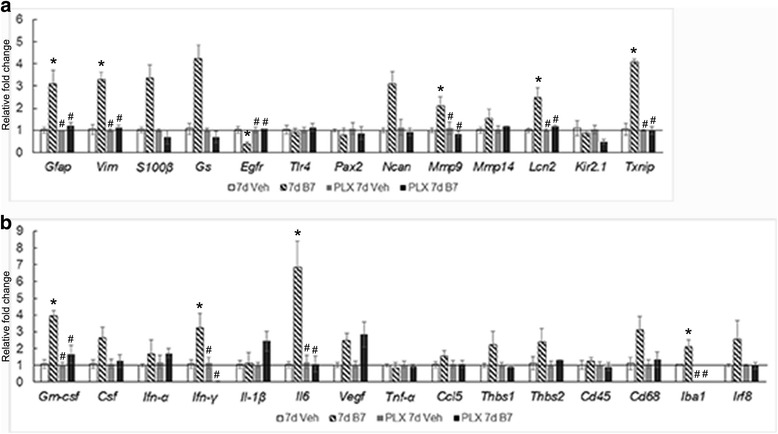Fig. 7.

Effect of BMP7 is diminished in the absence of microglia—RNA levels. BMP7 or vehicle was injected intravitreally into the eyes of mice kept on regular chow or PLX chow and harvested 7 days postinjection. RNA isolated from the retina were analyzed via RT-qPCR for changes in levels of inflammatory markers (a) and gliosis markers (b). Mice kept on the control chow and injected with BMP7 showed a relative increase by 2-fold or greater of inflammatory markers: Gm-csf, Csf, Ifn-γ, Il-6, Vegf, Thbs1, Thbs2, and CD68 (b). Gliosis markers Gfap, Vim, S100-β, Gs, Ncan, Mmp9, Lcn2, and Txnip showed a 2-fold increase or more in these mice (a). Data shown in graphs (a, b) represent relative expression levels of RNA in mouse retina to the respective vehicle treatments. Bars above a level of 1.0 (solid black line) represent an increase in mRNA levels while bars below the level of 1.0 represent a decrease in mRNA levels relative to the corresponding vehicle control. Mice kept on the PLX chow and injected with BMP7 showed a 2-fold increase in inflammatory markers Il-1β and Vegf, while all the gliosis markers showed relatively unchanged RNA levels (a, b). Statistical analysis was performed by one way ANOVA with post hoc Tukey test. Significant difference from vehicle-injected control mice *p value <0.05. Significant difference from BMP7 injected control mice #p value <0.05. Abbreviations: Csf colony stimulating factor, Egfr epidermal growth factor receptor, Gm-csf granulocyte macrophage colony stimulating factor, Gfap glial fibrillary acidic protein, Gs glutamine synthetase, Ifn-γ interferon-gamma, Il interleukin, Lcn lipocalin, Mmp matrix metalloproteinase, Ncan neurocan, Pcan phosphacan, Txnip thioredoxin interacting protein, Tnf-α tumor necrosis factor alpha, Thbs thrombospondin, Tlr toll like receptor, Vim vimentin, Vegf vascular endothelial growth factor
